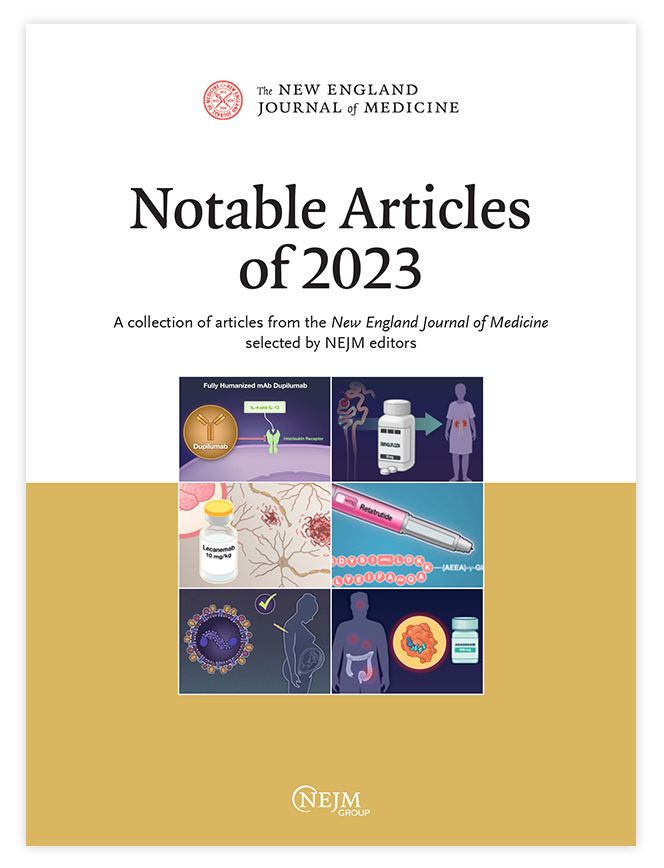西马鲁肽治疗代谢功能障碍相关脂肪性肝炎的3期临床试验。
IF 96.2
1区 医学
Q1 MEDICINE, GENERAL & INTERNAL
引用次数: 0
摘要
semaglutide是一种胰高血糖素样肽-1受体激动剂,是治疗代谢功能障碍相关脂肪性肝炎(MASH)的候选药物。在这项正在进行的3期、多中心、随机、双盲、安慰剂对照试验中,我们将1197例活检定义的MASH和纤维化2期或3期患者按2:1的比例分配给每周一次、剂量为2.4 mg的皮下semaglutide或安慰剂,持续240周。计划在第72周进行的涉及前800名患者的中期分析结果在此报告(第1部分)。第一部分的主要终点是脂肪性肝炎的缓解而不加重肝纤维化和肝纤维化的减少而不加重脂肪性肝炎。结果:在534例西马鲁肽组患者中,62.9%的患者脂肪性肝炎的消退没有纤维化恶化,而在266例安慰剂组患者中,这一比例为34.3%(估计差异为28.7个百分点;95%置信区间[CI], 21.1 ~ 36.2;P < 0.001)。据报道,西马鲁肽组36.8%的患者肝纤维化减轻,而脂肪性肝炎没有恶化,安慰剂组为22.4%(估计差异为14.4个百分点;95% CI, 7.5 ~ 21.3;P < 0.001)。包括在调整多重测试计划中的三个次要结局的结果如下:西马鲁肽组中32.7%的患者报告脂肪性肝炎和肝纤维化减轻,安慰剂组中16.1%(估计差异为16.5个百分点;95% CI, 10.2 ~ 22.8;P < 0.001)。西马鲁肽组体重的平均变化为-10.5%,安慰剂组为-2.0%(估计差异为-8.5个百分点;95% CI, -9.6 ~ -7.4;P < 0.001)。身体疼痛评分的平均变化在两组之间没有显著差异。胃肠道不良事件在西马鲁肽组中更为常见。结论:对于中度或晚期肝纤维化患者,每周一次、剂量为2.4 mg的西马鲁肽可改善肝脏组织学结果。(由诺和诺德投资;ClinicalTrials.gov号码:NCT04822181)。本文章由计算机程序翻译,如有差异,请以英文原文为准。
Phase 3 Trial of Semaglutide in Metabolic Dysfunction-Associated Steatohepatitis.
BACKGROUND
Semaglutide, a glucagon-like peptide-1 receptor agonist, is a candidate for the treatment of metabolic dysfunction-associated steatohepatitis (MASH).
METHODS
In this ongoing phase 3, multicenter, randomized, double-blind, placebo-controlled trial, we assigned 1197 patients with biopsy-defined MASH and fibrosis stage 2 or 3 in a 2:1 ratio to receive once-weekly subcutaneous semaglutide at a dose of 2.4 mg or placebo for 240 weeks. The results of a planned interim analysis conducted at week 72 involving the first 800 patients are reported here (part 1). The primary end points for part 1 were the resolution of steatohepatitis without worsening of liver fibrosis and reduction in liver fibrosis without worsening of steatohepatitis.
RESULTS
Resolution of steatohepatitis without worsening of fibrosis occurred in 62.9% of the 534 patients in the semaglutide group and in 34.3% of the 266 patients in the placebo group (estimated difference, 28.7 percentage points; 95% confidence interval [CI], 21.1 to 36.2; P<0.001). A reduction in liver fibrosis without worsening of steatohepatitis was reported in 36.8% of the patients in the semaglutide group and in 22.4% of those in the placebo group (estimated difference, 14.4 percentage points; 95% CI, 7.5 to 21.3; P<0.001). Results for the three secondary outcomes that were included in the plan to adjust for multiple testing were as follows: combined resolution of steatohepatitis and reduction in liver fibrosis was reported in 32.7% of the patients in the semaglutide group and in 16.1% of those in the placebo group (estimated difference, 16.5 percentage points; 95% CI, 10.2 to 22.8; P<0.001). The mean change in body weight was -10.5% with semaglutide and -2.0% with placebo (estimated difference, -8.5 percentage points; 95% CI, -9.6 to -7.4; P<0.001). Mean changes in bodily pain scores did not differ significantly between the two groups. Gastrointestinal adverse events were more common in the semaglutide group.
CONCLUSIONS
In patients with MASH and moderate or advanced liver fibrosis, once-weekly semaglutide at a dose of 2.4 mg improved liver histologic results. (Funded by Novo Nordisk; ClinicalTrials.gov number, NCT04822181.).
求助全文
通过发布文献求助,成功后即可免费获取论文全文。
去求助
来源期刊

New England Journal of Medicine
医学-医学:内科
CiteScore
145.40
自引率
0.60%
发文量
1839
审稿时长
1 months
期刊介绍:
The New England Journal of Medicine (NEJM) stands as the foremost medical journal and website worldwide. With an impressive history spanning over two centuries, NEJM boasts a consistent publication of superb, peer-reviewed research and engaging clinical content. Our primary objective revolves around delivering high-caliber information and findings at the juncture of biomedical science and clinical practice. We strive to present this knowledge in formats that are not only comprehensible but also hold practical value, effectively influencing healthcare practices and ultimately enhancing patient outcomes.
 求助内容:
求助内容: 应助结果提醒方式:
应助结果提醒方式:


